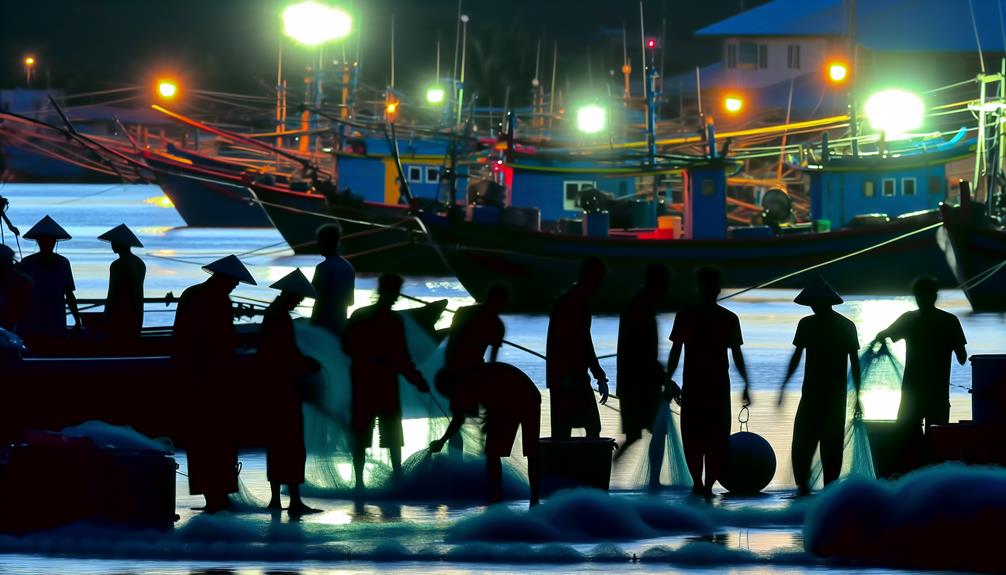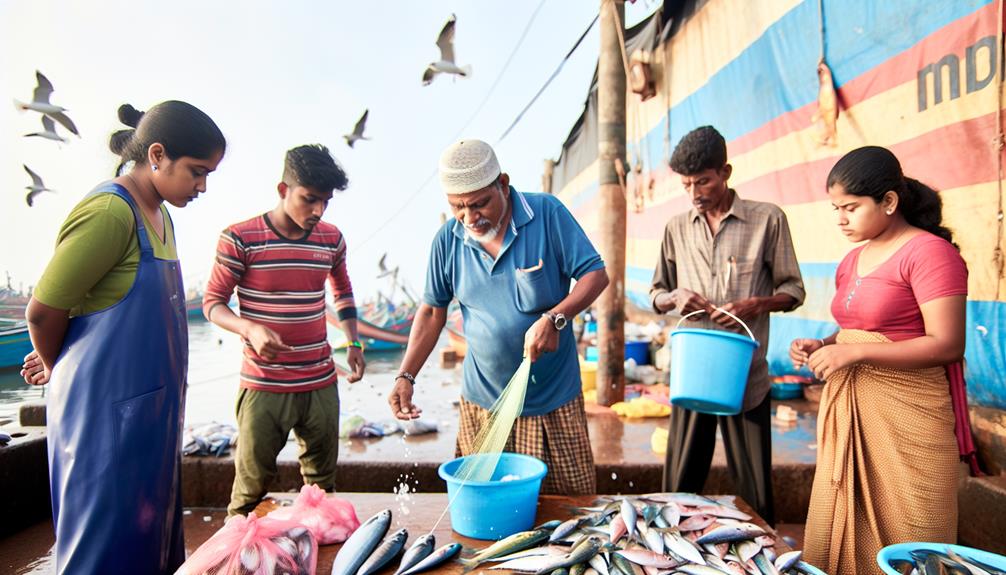Have you ever stopped to think about the sheer determination and resilience it takes to be a fisherman at Fisherman’s Wharf? The early morning hours, the unpredictable weather conditions, the intricate tools of the trade—these are just the tip of the iceberg when it comes to the daily lives of these hardworking individuals. But what really goes on behind the scenes? Stay tuned to uncover the untold stories of the working fishermen and the unique bond that ties this community together.
Table of Contents
ToggleKey Takeaways
- Skilled fishermen use techniques like longlining and trawling for optimal catches.
- Fishermen face and overcome challenges like turbulent storms with resilience and adaptability.
- Collaboration and camaraderie are essential among fishermen for mutual support and productivity.
- Sustainable fishing practices and adherence to regulations protect marine biodiversity and ensure seafood availability.
The Early Morning Catch

As the dawn breaks over the horizon, the fishermen at Fisherman’s Wharf begin their day by setting out to sea in search of the day’s catch. The quest for fresh seafood drives these skilled individuals to employ a variety of fishing techniques to maximize their yield. From traditional methods like longlining and trawling to more modern approaches such as using fish aggregating devices, these fishermen utilize their expertise to navigate the waters and secure the finest catches.
Fishing techniques play a crucial role in the success of these fishermen. Longlining involves setting out lines with baited hooks to attract fish like tuna and swordfish. Trawling, on the other hand, utilizes a large net dragged along the seabed to catch bottom-dwelling species such as cod and flounder. Additionally, the strategic deployment of fish aggregating devices helps concentrate fish in a specific area, making it easier for fishermen to haul in their desired targets.
Through a combination of experience and innovation, the fishermen at Fisherman’s Wharf consistently deliver high-quality fresh seafood to the market, showcasing their dedication to their craft.
Weathering the Storms
Navigating the unpredictable waters of the sea, the working fishermen of Fisherman’s Wharf must skillfully navigate and endure the challenges brought forth by turbulent storms. When facing rough waters, these experienced fishermen showcase their resilience and adaptability to changing conditions. Storms at sea can be intense, with strong winds and high waves threatening the stability of their vessels. In such situations, the fishermen rely on their years of experience to maneuver through the turbulent seas safely.
Staying resilient in the face of harsh weather conditions is crucial for the fishermen’s safety and success. They need to constantly monitor the changing weather patterns, preparing themselves for any sudden shifts that could endanger their fishing operations. By staying alert and proactive, they can make informed decisions to protect both themselves and their catch from the wrath of the storm.
Adapting to the changing conditions requires quick thinking and resourcefulness. Fishermen may need to adjust their fishing techniques, alter their routes, or even seek shelter until the storm passes. Through their ability to adapt swiftly, the working fishermen of Fisherman’s Wharf demonstrate their skill and dedication to their craft even in the most challenging situations.
Tools of the Trade

When equipping themselves for their fishing expeditions, the working fishermen of Fisherman’s Wharf meticulously select and maintain their essential tools of the trade. To ensure successful catches and safe operations at sea, fishermen rely on a combination of fishing techniques, gear maintenance practices, safety measures, and efficient boat operations.
- Fishing Techniques
- Fishermen employ various methods such as longlining, gillnetting, and trolling to target specific species based on depth, season, and migratory patterns.
- Gear Maintenance
- Regularly inspecting and repairing nets, lines, hooks, and other equipment is crucial to prevent malfunctions that could lead to lost catches or accidents.
- Safety Measures & Boat Operations
- Prioritizing safety, fishermen equip their boats with emergency supplies, communication devices, and navigation tools while following protocols for handling rough waters and adverse weather conditions.
Community and Camaraderie
In the tight-knit community of Fisherman’s Wharf, camaraderie among working fishermen is evident in their shared experiences, collaborative efforts, and mutual support. Friendship is a fundamental aspect of their interactions, with bonds forged through the challenges and triumphs of their profession. Cooperation is ingrained in their daily routines, as they often rely on each other to navigate the unpredictable waters and ensure successful fishing expeditions.
Within this community, a spirit of camaraderie permeates every aspect of their work. Whether mending nets, preparing equipment, or sharing knowledge about the best fishing spots, fishermen engage in a constant exchange of expertise and assistance. This mutual support not only strengthens their individual capabilities but also fosters a sense of unity and belonging among them.
Through their shared passion for the sea and fishing, these working fishermen have built a network of trust and collaboration that extends beyond the docks. Their camaraderie not only enhances their productivity but also enriches their lives, creating a supportive environment where friendship and cooperation thrive.
Sustainable Fishing Practices

To ensure the long-term health of fish populations, implementing sustainable fishing practices is imperative for the working fishermen of Fisherman’s Wharf. As stewards of the ocean, it is crucial to consider marine conservation and the impact of seafood consumption on our ecosystems. By adhering to fishing regulations and promoting sustainable practices, fishermen play a vital role in maintaining ocean health for future generations.
- Marine Conservation: By practicing sustainable fishing methods, fishermen contribute to the preservation of marine biodiversity and the overall health of ocean ecosystems.
- Seafood Consumption: Sustainable fishing practices ensure that fish stocks are not depleted beyond their capacity to recover, safeguarding the availability of seafood for present and future generations.
- Fishing Regulations: Adhering to fishing regulations helps prevent overfishing and ensures that fishing activities are managed in a way that promotes sustainability and environmental responsibility.





